Climate, Agriculture, and Population: Environmental Archaeological Research Based on Big Data Analysis | Lecture Announcement
On October 20, 2023, the "Archaeological Science Forum" hosted by the Center for Archaeological Science, Sichuan University was held in the Lecture Hall on the first basement floor of the Liberal Arts Building II, Jiang'an Campus, Sichuan University. Professor Lv Hongliang of the School of History and Culture, Sichuan University, presided over the forum.
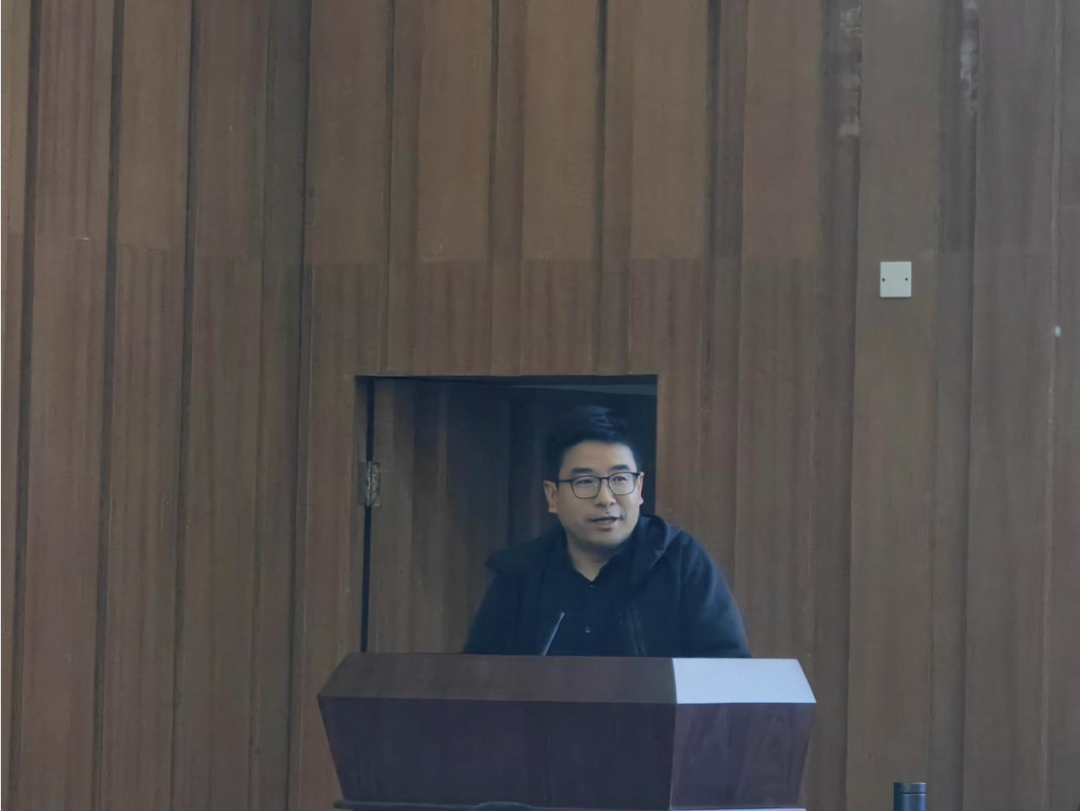
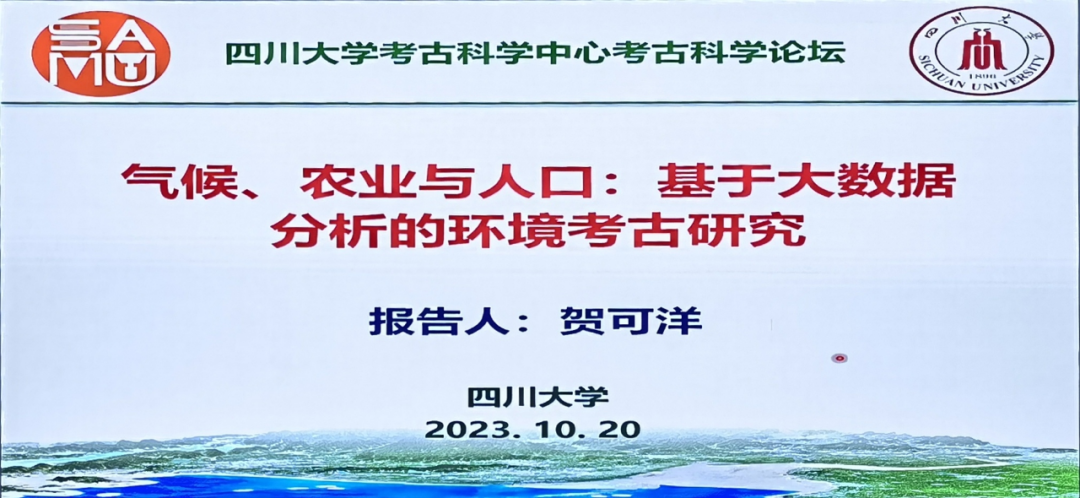
He Keyang pointed out that climate, agriculture, and population represent the three core elements in the study of prehistoric human-land relationships and are the key research areas of environmental archaeology. One of the biggest challenges in exploring the relationship between past climatic events and human societies is how to quantitatively reconstruct high-resolution spatiotemporal records of climate, agriculture, and population. This study quantitatively reconstructed the evolutionary sequence of prehistoric agricultural structure and population fluctuations in China by establishing a prehistoric archaeobotanical and archaeological radiocarbon database in China, comparing the spatiotemporal differences in agricultural and population evolution in different regions. Focusing on two key periods of the Holocene environmental and archaeological record coupling, 6ka and 4.2ka, and combining high-resolution climatic environmental records, the study explores the differences in the impact of regional climatic environmental changes on human society and the elastic adaptation mechanisms of human society. Around 6000cal BP, a transformation occurred in millet agriculture in China. It is manifested as a shift from foxtail millet to broomcorn millet as the main crop. Secondly, millet agriculture in the northern region initially concentrated on the Loess Plateau and the edge of the Inner Mongolia Plateau, and then spread westward and northward in a dynamic trend.
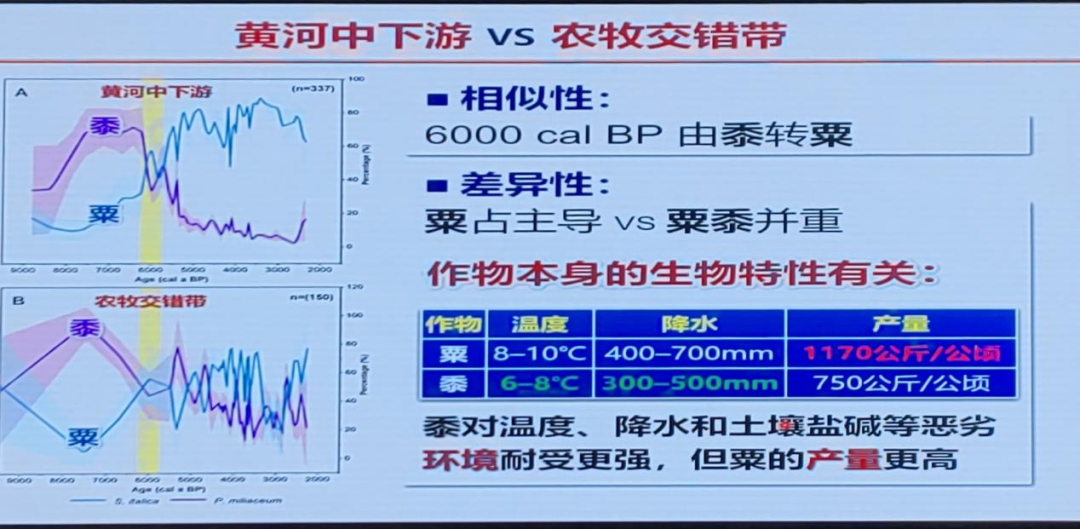
The Transformation of Millet Agriculture in China around 6000cal BP
There are many reasons for the transformation of millet agriculture. During the period of 8000-6000 years, the temperature and precipitation formed a good pattern suitable for crop growth, which promoted agricultural transformation. In addition, the same period witnessed significant cultural expansion and population explosion in northern China, and the pressure for survival also prompted people to choose millet agriculture with higher yields. With the improvement of farmland management technology, the application of fertilization technology also provided conditions for agricultural transformation.
Regarding the response of the 4.2ka climate event and population change. The impact of climate change on human society is both periodic and sudden. Among many catastrophic event studies, the 4.2ka event has become an important period for studying global climate change and human social development due to its global nature.
During and after the 4.2ka climate event, drastic changes took place in the cultural center and regional population development in China. However, the relationship between culture, population, agriculture, and the 4.2ka climate event still needs to be explored. The existing evidence has low resolution and is discontinuous, making it difficult to conduct high-precision, cross-regional comparisons.
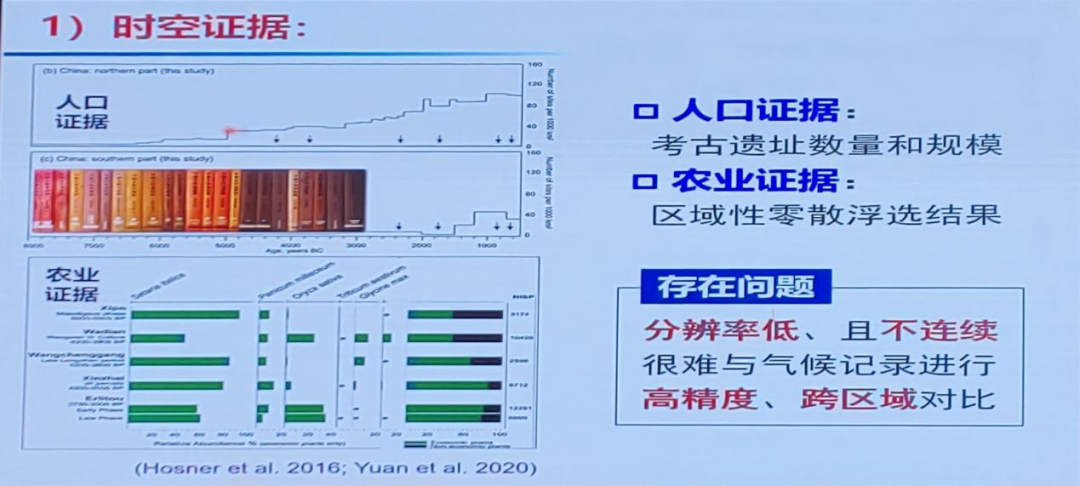
Problems in Previous Studies. Focusing on the relationship between population, environment, and agriculture, the project innovates in research materials, methods, and research models, attempting to solve the following two problems. The first is the development model of population and agriculture in different regions under the influence of the 4.2ka event; the second is how these regions adjust their strategies to cope with the impact of the 4.2ka event. By summarizing radiocarbon, archaeobotanical, and surrounding high-resolution, quantitative climatic environmental record data of archaeological materials, a coupling relationship is established between the scale of population activity and radiocarbon data to determine the regional population size and activity intensity, and data screening, analysis, merging, and correction methods are used to eliminate interference factor deviations as much as possible.
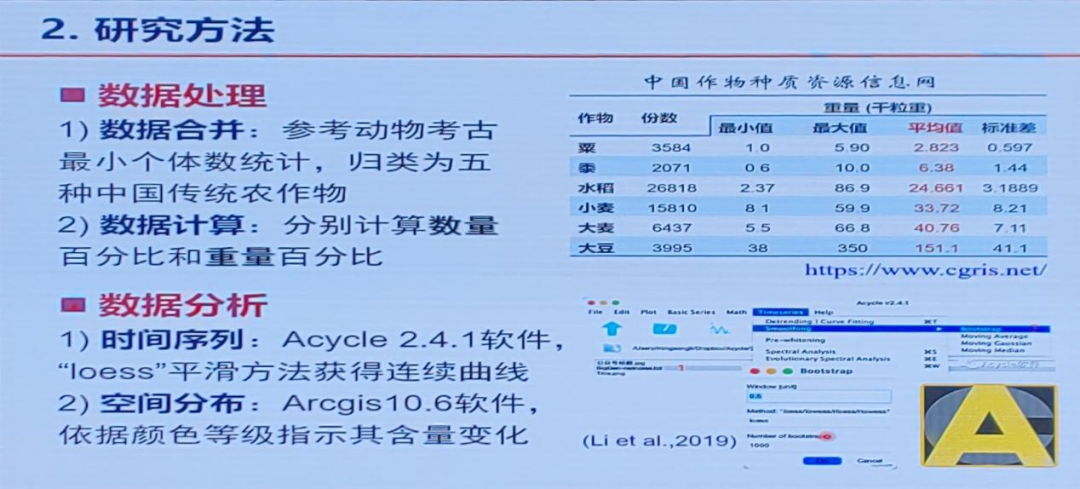
Research Methods
Data analysis shows that during the 4.2ka event, the rise in population in northwest China and the decline in population in southeast China are consistent with the prosperity of millet agriculture and the decline of rice agriculture. Possible reasons include climate and agricultural development.
Firstly, the climate is affected by the weakening of the summer monsoon and the superposition of the El Ni帽o phenomenon, presenting a climate pattern of cooling in the east and drying in the north and wetting in the south in China, causing extreme drought events in western Liaoning and other regions, triggering the collapse of regional millet agriculture. However, only drought trends appeared in Gansu, Qinghai, and the Central Plains, which did not exceed the tolerance range of millet agriculture, and it can even be said that it was a beneficial moderate drought. Significant cooling events occurred in the southeastern region, causing a substantial shrinkage in the rice planting area. During the same period, the lower reaches of the Yangtze River entered an extremely humid state, and frequent floods and rising sea levels exacerbated the decline of rice agriculture.
In terms of agricultural cultural strategies, approximately in the area affected by the 4.2ka event, climate change promoted the opening of the oasis channel and accelerated cultural exchanges between the Eurasian continent. The Central Plains and Northwest regions opened up and accepted new species, promoting crop diversification and the development and utilization of multiple landform landscapes, enhancing environmental carrying capacity, and buffering the negative impact of climate change. The southeastern region was relatively closed, which aggravated the collapse of rice agriculture and the decline of the population.
Cultural Exchange Comparison
Research shows that the differences in population and agriculture in northwest and southeast China may indicate two social evolution models. When faced with the sudden climatic and environmental event of 4.2ka, the northwestern region, due to its relatively low-intensity, extensive millet agriculture, showed strong resilience and adaptability in its more open population and agricultural model, while the southeastern region, due to its intensive and specialized rice agriculture and highly differentiated and high-level population and agricultural model, showed a relatively rigid trend, making it more vulnerable to negative impacts and collapse.
In summary, during the 6000cal BP period, the transformation and diffusion of millet agriculture in northern China was affected by many factors such as warm and humid climate, population pressure, and agricultural management methods. The planting model changed from foxtail millet to high-yielding broomcorn millet, gradually spreading from the middle and lower reaches of the Yellow River to the agro-pastoral ecotone. During the 4.2ka climate change event, prehistoric millet and rice agriculture and population in China showed an inverse development trend. Moderate drought and trans-Eurasian technological and cultural exchanges promoted the continued development of millet agriculture and population prosperity in the Northwest region. Cold events superimposed with frequent floods and social conflicts led to the decline of rice agriculture and population reduction in the Southeast region.

Professor Huang Chengmin (School of Architecture and Environment) of the Center for Archaeological Science made a comprehensive review. He pointed out that this is a typical case of combining scientific archaeological methods with empirical materials, interpreting archaeological research from multiple perspectives, and conducting in-depth integrated cultural interpretation. Multi-disciplinary in-depth participation in scientific archaeology, traditional archaeology, and multi-disciplinary integrated cultural interpretation based on archaeological research are new directions for future research and are worth further exploration. In addition, the participating teachers and students had in-depth discussions on some of the issues in the report and jointly explored new paths for multi-disciplinary interdisciplinary archaeological research. Review by Professor Huang Chengmin
About the Speaker:
He Keyang is currently a specially-appointed associate researcher at the Center for Archaeological Science, Sichuan University. He is mainly engaged in research in the field of environmental archaeology. Through the analytical methods of "multi-indicator microfossils" and "archaeological big data quantification", he carries out research on paleoecological environment reconstruction, agricultural origin and dissemination, and prehistoric human-land relationships. Currently, he has published 10 research papers as the first author in journals such as Quaternary Science Reviews, Earth System Science Data, Journal of Archaeological Science, and Science China: Earth Sciences, co-published 13 papers, and undertaken 2 projects of the National Natural Science Foundation of China for young scientists.
Reviewer:
Huang Chengmin, Professor, School of Architecture and Environment, Sichuan University
